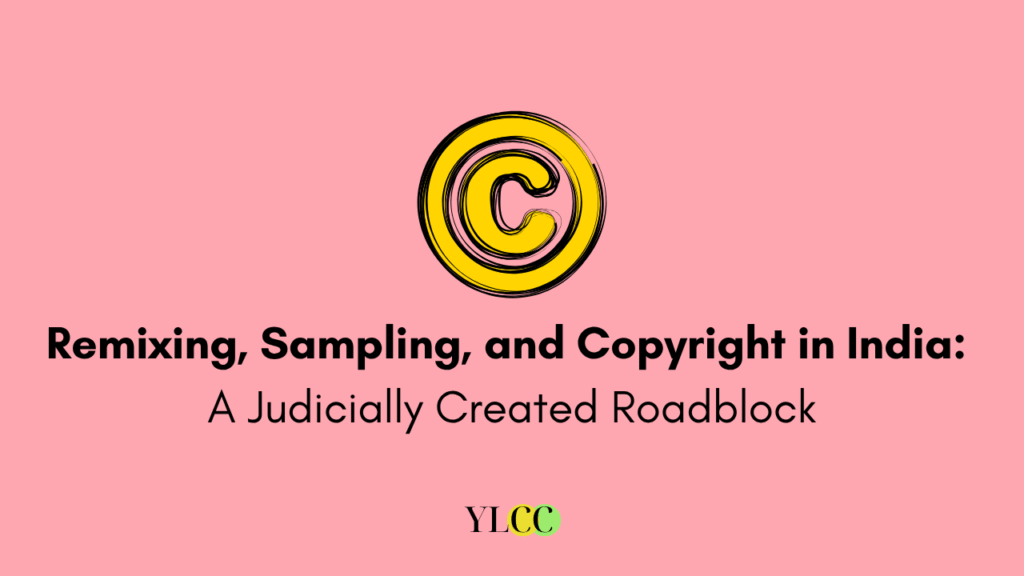
Introduction
When Super Cassette Industries Ltd. (SCIL) released remixed versions of Hindi film songs in the mid-1990s, they likely viewed it as a tribute to past music, a means of reimagining popular melodies. However, their venture quickly became embroiled in a legal battle that would shape the future of remixing and sampling in India. The case, Gramophone Company of India Ltd. v. Super Cassette Industries Ltd. (1996), brought to the forefront the restrictive nature of Indian copyright law regarding musical modifications. The court’s ruling made it clear that remixing without explicit permission from the original copyright holders was not an artistic reinterpretation but a direct violation of copyright law.
Nearly a decade later, in Star India Pvt. Ltd. v. Leo Burnett (2003), the Bombay High Court reaffirmed this hardline approach, holding that even the slightest modification to a jingle required proper authorization. Together, these rulings cemented the restrictive legal environment surrounding remixing and sampling in India, making it one of the most challenging jurisdictions for artists seeking creative freedom through musical modifications.
At the core of these cases lies an important question: Should copyright protection be absolute, or should there be room for creative reinterpretation? Indian courts have consistently favored copyright holders, placing significant limits on remixing and sampling, particularly when commercial interests are involved. As a result, the Indian music industry has become mired in judicial precedents that stifle creativity rather than encourage artistic expression. This paper explores how the Gramophone Company and Star India cases have shaped India’s copyright framework, making licensing a complicated and burdensome process, limiting fair use, and leaving artists uncertain of their legal standing. By comparing India’s legal approach to international practices, it becomes clear that reform is essential to accommodate contemporary creative practices.
Judicial Precedents: The Legal Walls Against Remixing and Sampling
Gramophone Company v. Super Cassette: Copyright as an Absolute Right
The Gramophone Company case laid the foundation for India’s restrictive stance on remixing. The dispute began when Super Cassette Industries Ltd. (SCIL) remixed and modified songs owned by the Gramophone Company of India Ltd. (GCI) without obtaining proper authorization. SCIL argued that their remixes were new artistic expressions, distinct from the original tracks. However, the court rejected this argument, ruling that:
- Remixing constitutes unauthorized reproduction and adaptation, thereby infringing upon the original copyright holder’s rights.
- Even if a remix introduces modifications, the “essence” of the original composition remains protected under copyright law.
- Commercial intent negates any claim of fair dealing, making unlicensed remixing illegal.
By defining copyright as an absolute right, this ruling made it nearly impossible for artists to create remixes without securing permissions from multiple copyright holders. More significantly, it rejected the argument that remixing could be considered a transformative work, an idea that has found acceptance in many international copyright regimes.
Star India v. Leo Burnett: No Room for “Minor” Modifications
The Star India case further solidified the precedent set by Gramophone Company, expanding its application to include not only full-length songs but also shorter musical compositions like jingles. In this case, Leo Burnett, an advertising agency, modified a jingle owned by Star India for use in a different commercial. Star India sued for copyright infringement, asserting that the modification was unauthorized.
The Bombay High Court ruled in favor of Star India, establishing that:
- Even minor modifications to a copyrighted work require proper licensing, reinforcing the broad scope of copyright protection.
- Fair use cannot be claimed when a copyrighted work is used for commercial purposes.
- The original copyright holder retains both economic and moral rights, even if the alterations are minimal.
This ruling extended the impact of Gramophone Company, making it clear that no creative reinterpretation—no matter how small—was legally permissible without the original creator’s authorization. The court’s decision reinforced India’s preference for safeguarding economic rights over encouraging artistic flexibility. This legal framework restricts the evolution of music, especially at a time when remix culture is becoming increasingly significant.
Fair Use: A Defense That Holds No Ground in India
Both the Gramophone Company and Star India cases reveal the limited applicability of fair dealing provisions under Indian copyright law, especially when commercial interests are involved. While fair use in many jurisdictions allows for transformative works—such as parodies or remixing—Indian courts have historically interpreted Section 52 of the Copyright Act, 1957, in a restrictive manner.
In contrast, countries like the United States offer more flexibility through their transformative use doctrine, as established in the landmark case Campbell v. Acuff-Rose Music (1994), where the U.S. Supreme Court ruled that parody and transformative works could qualify as fair use. However, Indian courts rejected a similar argument in Gramophone Company, ruling that commercial intent nullifies any claim of artistic justification.
This stance in India starkly contrasts with international copyright practices, where remixing and sampling are often seen as legitimate forms of creative expression. By rejecting fair use and transformative works, Indian copyright law has effectively deterred the remix culture that has flourished in many other parts of the world.
Licensing Complexities: A System Designed to Deter Creativity
In the wake of Gramophone Company and Star India, the legal system has created an overly complex and discouraging licensing process for artists who want to remix or sample existing works. Under India’s current copyright regime, artists must obtain permissions from:
- The original composer (for melody rights).
- The lyricist (for lyrical rights).
- The recording label (for performance and recording rights).
Organizations like the Indian Performing Rights Society (IPRS) and Phonographic Performance Limited (PPL) assist in facilitating these licenses, but the process is often time-consuming, costly, and discourages independent artists from participating in remix culture.
Further complicating matters, the Star India ruling reaffirmed the moral rights clause under Section 57 of the Copyright Act, which allows original creators to object to modifications if they believe their artistic integrity is compromised. As a result, even after obtaining the necessary permissions, artists may still face legal challenges if the original creator disapproves of the remix.
Global Comparisons: How Other Jurisdictions Handle Remix Culture
While India has adopted a restrictive approach to remixing and sampling, other jurisdictions have found more balanced ways to protect copyright while allowing for creative reinterpretation:
- United States: In Bridgeport Music Inc. v. Dimension Films (2005), the court ruled that “Get a license or do not sample,” which mirrors India’s stance. However, U.S. copyright law still allows for transformative fair use, as demonstrated in Campbell v. Acuff-Rose Music (1994).
- United Kingdom: UK copyright law provides for exceptions to copyright protection, particularly in cases of transformative use under its fair dealing provisions. In Dramatico Entertainment Ltd. v. BPI (2012), the UK court ruled in favor of more flexibility, allowing certain creative uses without needing explicit permission from the original copyright holder.
The Need for Reform: A More Balanced Copyright Regime
India’s rigid copyright structure, largely shaped by the rulings in Gramophone Company and Star India, fails to align with the evolving landscape of modern music production. To ensure that the Indian music industry remains competitive and supportive of creativity, the following reforms are necessary:
- Simplified Licensing System: A streamlined, single-window clearance for remixing and sampling would eliminate bureaucratic delays and costs.
- Fair Use Expansion: Adopting a more flexible transformative use standard—similar to the U.S. model—would allow artists to engage in creative reinterpretations without undermining copyright protections.
- Clarity on Moral Rights: While moral rights should be protected, they should not be applied in a way that hinders artistic innovation, particularly in cases of remixing and sampling.
Conclusion
The legal rulings in Gramophone Company v. Super Cassette and Star India v. Leo Burnett have defined copyright law in India, but at what cost? These rulings, while reinforcing copyright protection, have created significant barriers for remixers, DJs, and independent artists. In contrast, other jurisdictions have adapted their copyright laws to better accommodate remix culture, offering more flexibility for transformative works.
To foster a more dynamic and innovative music industry in India, the legal system must strike a balance between protecting copyright and allowing creative freedom. Without such reforms, remixing—the powerful tool for musical innovation—will remain legally vulnerable, stifled by outdated legal frameworks that fail to embrace the rapidly evolving nature of music.
References:
Case Laws:
- Gramophone Co. of India Ltd. v. Super Cassette Indus. Ltd., A.I.R. 1996 S.C. 1631 (India).
- Star India Pvt. Ltd. v. Leo Burnett, (2003) 27 P.T.C. 81 (Bom.) (India).
- Campbell v. Acuff-Rose Music, Inc., 510 U.S. 569 (1994).
- Bridgeport Music, Inc. v. Dimension Films, 410 F.3d 792 (6th Cir. 2005).
- Dramatico Ent. Ltd. v. British Phonographic Indus. Ltd., [2012] E.W.H.C. 268 (Ch.) (Eng.).
Statutes and Legal Instruments:
- The Copyright Act, No. 14 of 1957, India Code (1957).
- Copyright, Designs and Patents Act 1988, c. 48 (U.K.).
- Copyright Act, 17 U.S.C. § 107 (2018) (U.S.).
Books and Articles:
- TREVOR APLIN & JENNIFER DAVIS, INTELLECTUAL PROPERTY LAW: TEXT, CASES, AND MATERIALS (4th ed. 2021).
- N.S. GOPALAKRISHNAN, THE LAW OF INTELLECTUAL PROPERTY RIGHTS (2014).
- Shamnad Basheer, “Remix Rights and Copyright Law in India: An Analysis of Judicial Trends,” 20 J. INTELL. PROP. RTS. 156 (2015).
Reports and Online Resources:
- Indian Performing Rights Society (IPRS), Licensing Guidelines and Music Usage, IPRS Website (last visited Mar. 11, 2025).
- Phonographic Performance Limited (PPL), Music Licensing in India, PPL India Website (last visited Mar. 11, 2025).
- Ministry of Commerce & Industry, Copyright and Related Rights in India, GOV’T OF INDIA REPORT (2022).
This article has been written by Krupa Gangar. For any other queries, reach out to us at: queries.ylcc@gmail.com






